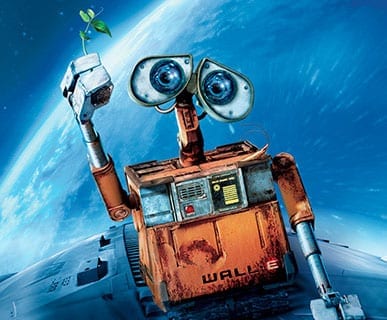WALL-E
From dump to infinity

When I heard that Pixar had been bought by Disney Studios, I wondered what would happen with the quality standard of the company’s productions, responsible for gems like “Toy Story”, “Monsters, Inc”, “Finding Nemo”, “The Incredibles”, etc … Although no savage Hollywood capitalist has lost any sleep due to the concern of this film critic, I found, watching “WALL-E” (USA, 2008), that Pixar’s quality standard was maintained, despite being under the Disney flag.
To praise the quality of computer graphics for animation would, as the popular saying, take sand to the beach. The technical preciousness of the computer graphics used is increasingly detailed and realistic. The good news are the theme of the story and range of the audience, which covers children from zero up to a hundred years (who are above this range can go, too).
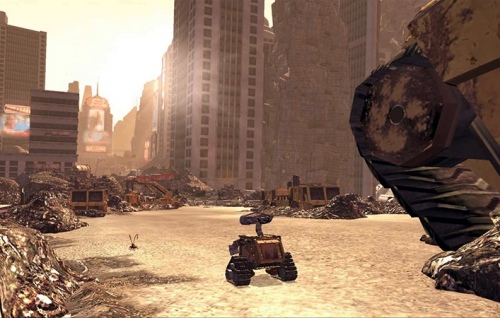
“WALL-E” touches on a very important theme, which only finds an echo in the discussions of environmentalists: garbage. Despite being a potentially devastating element, most people only worry when there is a strike by street sweepers. To give you an idea, Brazil alone generates almost 80 million tons of solid waste annually, poisoning the soil and filling the rivers and sea with plastics.
When the movie begins, we find a dusty and deserted Earth, abandoned by its inhabitants. In the first minutes, by an old propaganda, we discover that the Earthlings were taken to space, since Earth had been transformed in a huge garbage dump, polluted and lifeless.
In this inhospitable environment, we find WALL-E, a small robot remnant from an army of autonomous machines that aimed to compact the garbage into small cubes and store them in huge piles. Endowed with artificial intelligence and ability to self repair, WALL-E remained in operation during seven hundred years, always fulfilling its mission.

Living in this solitude, WALL-E developed its own personality, acquiring the habit of collecting objects that he considers interesting, such as lighters or jewelry boxes (the diamond ring he throws away), and continually watches the musical “Hello, Dolly” (USA, 1969), delighted with the relationship between people.
One day, its routine is broken with the arrival of a spaceship, which leaves another robot. This robot, called EVE, has the mission of scanning the Earth for signs of life. When WALL-E shows a plant specimen it found, EVE secures the sample and goes into hibernation. Soon, the ship will return to pick it up.
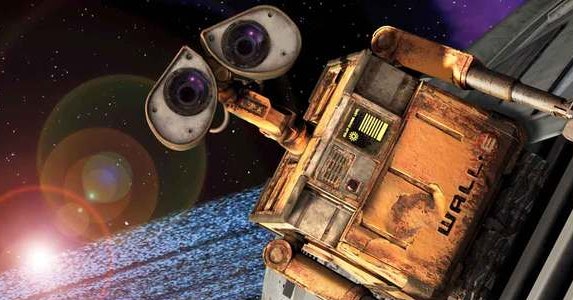
When EVE is collected, WALL-E hitches a ride on the spacecraft, which will take it on a journey through space, passing through a layer of space debris around the Earth (detail for Sputnik, the first satellite to be launched into space), by Solar system planets, until it gets to a faraway place, probably Orion’s nebula.
There, in a gigantic spaceship called AXION, we discover that the last remnants of Earth’s inhabitants were transformed into obese beings, harmed by low gravity, lack of physical activity and excessive junk-food. Everyone moves on floating chairs and sees only what is shown on television screens in front of them.
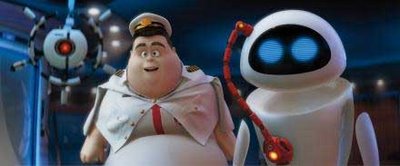
The ship’s commander, whose only duty is to make a daily statement, is surprised to discover that there was a guideline that conditioned the return to Earth to the existence of life – in this case, a vegetable.
But the computer Auto, the artificial intelligence that controls the ship, obeys an old secret directive, which ruled out any possibility of returning to Earth. For that, all evidence had to be eliminated, and that included WALL-E, EVE and any evidence of life on Earth. Now, it is up to the skipper and the two little robots to save the fate of all mankind.

Regardless of the technical resources used, “WALL-E” is already worth the ticket for being a totally visual film. Most of the movie there is no dialogue – dialogue in the strict sense, verbal. In fact, there are no communication problems, neither between the characters, nor with the viewer, because the few sounds used and the “facial” expressions of the robots are enough for the perfect understanding of the plot. WALL-E is a mixture of “Short Circuit” (USA, 1986) with “ET, the Extra-Terrestrial” (USA, 1982).
Other precious details are in the countless references to great sci-fi movies from 60s and 70s. “2001: A Space Odissey” (USA, 1968) is present, with Auto reviving HAL 9000, with its red eye, and even waltz “Thus spoke Zarathustra” by Strauss is the musical background of a beautiful space ballet. The viewer can be attentive to the quotes to “Star Wars” (USA, 1977), “Alien” (USA, 1979), “Blade Runner” (USA, 1982) and “Close Encounters of the Third Kind ” (USA, 1977).
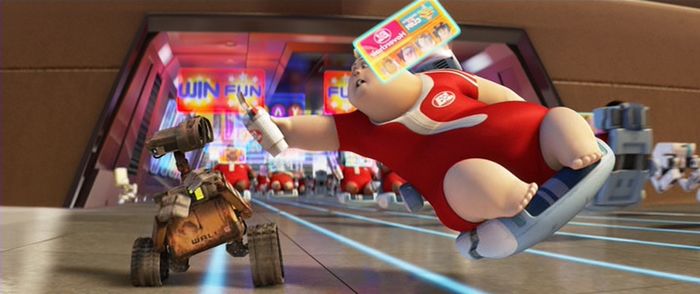
The creator of the voices of WALL-E and EVE was Ben Burtt, the sound designer who invented the “voice” of R2D2 and the sound of the lightsabers in “Star Wars”. The cinematography had the consultancy of Roger Deakins, who helped print the images with the effects of 70mm cameras used at the time of the great sci-fi productions. The wonderful soundtrack brings, among other gems, La Vie en Rose, performed by Louis Armstrong.
“WALL-E”, unlike other children movies, which are nothing more than a bunch of graphic effects, brings an interesting message, under the preservation of the environment, covered with a pleasant story that brings themes as precious as love, friendship and duty. More than recommended!

